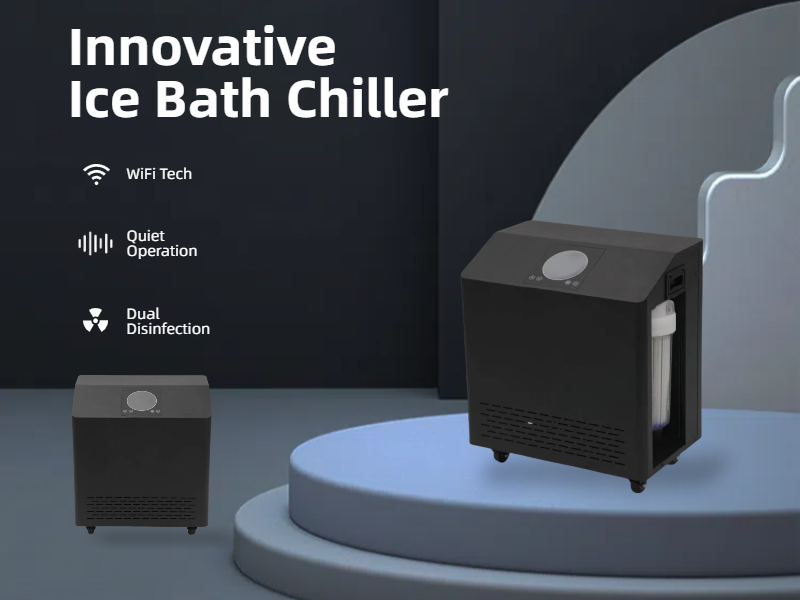ในช่วงไม่กี่ปีที่ผ่านมา เครื่องทำน้ำเย็นสำหรับแช่ตัวได้รับความสนใจเป็นอย่างมากในวงการสุขภาพและการฟื้นฟูสมรรถภาพนักกีฬา
อุปกรณ์ที่ทันสมัยเหล่านี้ถูกออกแบบมาเพื่อให้นักกีฬาและผู้ที่ชื่นชอบการออกกำลังกายสามารถเข้าถึงการบำบัดด้วยความเย็นได้อย่างมีประสิทธิภาพและรวดเร็ว เมื่อเราได้เจาะลึกถึงความก้าวหน้าล่าสุดของเครื่องทำน้ำเย็นสำหรับแช่ตัว เราจะได้ศึกษาเทคโนโลยี ประโยชน์ และผลกระทบของการใช้งานที่มีต่อการฟื้นฟูและประสิทธิภาพในการเล่นกีฬา
การพัฒนาของเครื่องทำน้ำเย็นสำหรับแช่ตัวมีความน่าทึ่ง โดยผู้ผลิตได้ใส่เทคโนโลยีที่ทันสมัยเพื่อเพิ่มประสบการณ์การใช้งานของผู้ใช้
เครื่องทำน้ำเย็นแบบทันสมัยมีระบบควบคุมดิจิทัล ซึ่งช่วยให้ผู้ใช้งานสามารถตั้งอุณหภูมิได้อย่างแม่นยำ และตรวจสอบการใช้งานได้อย่างง่ายดาย ระดับการปรับแต่งเช่นนี้จะช่วยให้นักกีฬาสามารถปรับการบำบัดด้วยความเย็นให้เหมาะกับความต้องการในการฟื้นฟูของตนเอง เพื่อเพิ่มประสิทธิภาพประโยชน์จากการาวน้ำแข็ง
หนึ่งในประโยชน์ที่สำคัญที่สุดของเครื่องทำน้ำเย็นสำหรับการาวน้ำแข็ง คือความสามารถในการลดอาการปวดเมื่อยกล้ามเนื้อและอาการบวมอักเสบ
หลังจากช่วงการฝึกซ้อมที่เข้มข้น นักกีฬามักจะประสบกับอาการปวดกล้ามเนื้อแบบเริ่มช้า (DOMS) ซึ่งอาจทำให้ประสิทธิภาพในการออกกำลังกายครั้งถัดไปลดลง การใช้เครื่องทำน้ำเย็นสำหรับการาวน้ำแข็ง จะช่วยให้นักกีฬาจัดการกับอาการปวดเมื่อยเหล่านี้ได้อย่างมีประสิทธิภาพ ส่งเสริมให้ร่างกายฟื้นตัวได้เร็วขึ้น และสามารถกลับมาฝึกซ้อมได้อีกในเวลาอันรวดเร็ว มีงานวิจัยแสดงให้เห็นว่า การแช่น้ำเย็นสามารถลดอาการอักเสบของร่างกายได้อย่างมีนัยสำคัญ ทำให้อุปกรณ์เหล่านี้กลายเป็นเครื่องมือที่จำเป็นสำหรับนักกีฬาอาชีพ
นอกจากนี้ ความสะดวกสบายที่ได้จากเครื่องทำน้ำเย็นสำหรับการาวน้ำแข็งนั้นไม่ควรมองข้ามเลย
ต่างจากอ่างน้ำแข็งแบบดั้งเดิมที่ต้องใช้น้ำแข็งจำนวนมากและอาจลำบากในการติดตั้ง เครื่องทำน้ำเย็นรุ่นใหม่ช่วยให้การบำบัดด้วยความเย็นเป็นเรื่องง่าย โดยมีขั้นตอนการติดตั้งและการใช้งานที่สะดวก เพียงแค่เสียบปลั๊กก็สามารถใช้งานได้ นักกีฬาจึงสามารถเพลิดเพลินกับประโยชน์ของการบำบัดด้วยความเย็นได้ทั้งที่บ้านหรือในศูนย์ฝึกอบรมมืออาชีพ ความสะดวกนี้ช่วยส่งเสริมให้นักกีฬามากขึ้นหันมาใช้การบำบัดด้วยความเย็นเป็นส่วนหนึ่งของกิจวัตรประจำวัน ส่งผลให้ประสิทธิภาพโดยรวมในการฝึกซ้อมดีขึ้น
เมื่ออุตสาหกรรมเพื่อสุขภาพยังคงเติบโต คาดว่าความต้องการโซลูชันการฟื้นฟูที่เป็นนวัตกรรม เช่น เครื่องทำความเย็นสำหรับแช่ในน้ำแข็ง จะเพิ่มสูงขึ้น
นักกีฬาเริ่มตระหนักถึงความสำคัญของการฟื้นตัวในช่วงการฝึกซ้อมมากขึ้น ส่งผลให้ตลาดอุปกรณ์เหล่านี้เติบโตอย่างรวดเร็ว ผู้ผลิตจึงอาจตอบสนองด้วยคุณสมบัติที่ล้ำสมัยยิ่งขึ้น เช่น การเชื่อมต่อกับแอปพลิเคชันติดตามการออกกำลังกาย เพื่อให้ผู้ใช้งานสามารถตรวจสอบข้อมูลการฟื้นตัวแบบเรียลไทม์ได้ เทรนด์นี้สะท้อนให้เห็นถึงการเปลี่ยนแปลงไปสู่แนวทางที่ใช้ข้อมูลเป็นศูนย์กลางในวงการกีฬาและสุขภาพ โดยเทคโนโลยีมีบทบาทสำคัญในการเพิ่มประสิทธิภาพการฝึกซ้อม
สรุปได้ว่า นวัตกรรมล่าสุดของเครื่องทำน้ำเย็นสำหรับแช่แข็งมีความก้าวหน้าอย่างมากในเทคโนโลยีการฟื้นตัวของนักกีฬา
ด้วยความสามารถในการลดอาการเมื่อยกล้ามเนื้อ เพิ่มความสะดวกสบาย และตอบสนองต่อความต้องการที่เพิ่มขึ้นของนักกีฬา อุปกรณ์เหล่านี้กำลังจะกลายเป็นส่วนหนึ่งที่ขาดไม่ได้ทั้งในแวดวงการฝึกซ้อมระดับมืออาชีพและระดับสมัครเล่น เมื่อมองไปข้างหน้า อนาคตของเครื่องทำน้ำเย็นสำหรับแช่แข็งดูสดใส ด้วยนวัตกรรมที่พัฒนาอย่างต่อเนื่อง ซึ่งมีแนวโน้มจะปฏิวัติวงการบำบัดด้วยความเย็นให้ก้าวหน้ายิ่งขึ้นไปอีก
แนวโน้มของอุตสาหกรรมแสดงให้เห็นถึงความสนใจที่เพิ่มขึ้นในโซลูชันฟื้นฟูร่างกายแบบเฉพาะบุคคล และเครื่องทำน้ำเย็นสำหรับแช่น้ำแข็งอยู่ในแนวหน้าของการเคลื่อนไหวนี้ เมื่อนักกีฬายิ่งมองหาวิธีที่มีประสิทธิภาพมากขึ้นในการเพิ่มศักยภาพการฟื้นตัว บทบาทของเทคโนโลยีในด้านนี้ย่อมขยายตัวอย่างไม่ต้องสงสัย ส่งผลให้มีผลิตภัณฑ์นวัตกรรมใหม่ๆ เกิดขึ้นเพื่อตอบสนองความต้องการที่เปลี่ยนแปลงไปของชุมชนสายสุขภาพ
สารบัญ
- ในช่วงไม่กี่ปีที่ผ่านมา เครื่องทำน้ำเย็นสำหรับแช่ตัวได้รับความสนใจเป็นอย่างมากในวงการสุขภาพและการฟื้นฟูสมรรถภาพนักกีฬา
- การพัฒนาของเครื่องทำน้ำเย็นสำหรับแช่ตัวมีความน่าทึ่ง โดยผู้ผลิตได้ใส่เทคโนโลยีที่ทันสมัยเพื่อเพิ่มประสบการณ์การใช้งานของผู้ใช้
- หนึ่งในประโยชน์ที่สำคัญที่สุดของเครื่องทำน้ำเย็นสำหรับการาวน้ำแข็ง คือความสามารถในการลดอาการปวดเมื่อยกล้ามเนื้อและอาการบวมอักเสบ
- นอกจากนี้ ความสะดวกสบายที่ได้จากเครื่องทำน้ำเย็นสำหรับการาวน้ำแข็งนั้นไม่ควรมองข้ามเลย
- เมื่ออุตสาหกรรมเพื่อสุขภาพยังคงเติบโต คาดว่าความต้องการโซลูชันการฟื้นฟูที่เป็นนวัตกรรม เช่น เครื่องทำความเย็นสำหรับแช่ในน้ำแข็ง จะเพิ่มสูงขึ้น
- สรุปได้ว่า นวัตกรรมล่าสุดของเครื่องทำน้ำเย็นสำหรับแช่แข็งมีความก้าวหน้าอย่างมากในเทคโนโลยีการฟื้นตัวของนักกีฬา






